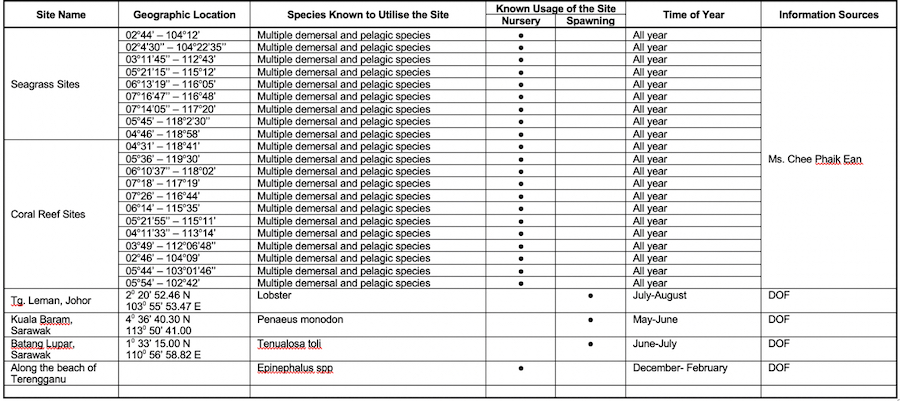Background & Situation Menu
Status and Trends in Fisheries and their Habitats Threats, root causes and barrier analysis Institutional, sectoral and policy context Stakeholder mapping and analysis Baseline analysis and gaps Known Areas of Critical Significance to the Life-Cycles of Fisheries Resources Priority Fisheries Refugia Areas




Establishment of Fisheries Refugia in Malaysia:
Background and Situation Analysis to Support
Known Areas of Critical Significance to the Life-Cycles of Fisheries Resources
Fish resources in the South China Sea are very important to Malaysia and a lot of studies have been done to determine its status. Contrary to that, very few efforts have been put into the study of fish larvae. The abundance of fish larvae is an indicator of fertile water. Published works on studies of fish larvae in Malaysian waters in the South China Sea are limited. Realizing this, the Fisheries Department had started to include fish larvae study in the fish resources survey that had been conducted regularly in Malaysian waters. Knowledge of morphology, spawning season, spawning, and nursery grounds are important for proper fisheries management.
The fish larvae survey in Southeast Asia was first carried out by Delsman in the Java Sea (1930). In the South China Sea, Vatanachai (1972) and Termvidchakorn (1999a, 1999b) reported a number of studies that were carried out by Southeast Asian Fisheries Development Center (SEAFDEC) on the Gulf of Thailand, East Coast of Peninsular Malaysia, West Sabah, Brunei Darussalam, and Sarawak. Several surveys on larval fish have been done in Malaysian waters by DoF Malaysia since 1999. Surveys conducted were not on a regular basis but depending on the budget available. Result of the surveys giving the preliminary information of spawning and nursery area based on the high density of fish egg and larvae. This information can be used in formulating fisheries management strategies.
The surveys can be divided into some different areas: Strait of Malacca on the west coast of Peninsular Malaysia, east coast of Peninsular Malaysia in the South China Sea, Sabah and Sarawak waters in the South China Sea and Sulu-Sulawesi Sea in the east coast of Sabah. Malaysia as a member country of SEAFDEC has collaborated in the sampling of larval fish in the South China Sea since 1999. A survey in the Strait of Malacca on the west coast of Peninsular Malaysia has been conducted in 2006. It covered the area between Langkawi Island in the north to Port Klang in the south. The high density of fish larvae and fish eggs were observed near the coastal areas off Pulau Langkawi, Matang Mangrove area. Off Kuala Selangor and Port Klang areas were also a high density of fish larvae and may relate to the one-fathom bank where it was reported that upwelling occurs which then supports the growth of phytoplankton & zooplankton and consumed by fish larvae. The top five families of fish larvae during study duration were Engraulidae, Bregmacerothidae, Gobiidae, Carangidae, and Scombridae. This study showed that mangrove areas and islands play an important role in spawning and nursery ground for fish species. Surveys in Sabah and Sarawak waters in 2010 showed that families Carangidae, Serranidae, Scombridae, Synodontidae, Clupeidae, and Lutjanidae were among the commercially important in the study area. The density of fish egg and larvae were higher near the coastal area compared to deeper water. The area of Luconia shoal was a high density of fish egg and larvae.
